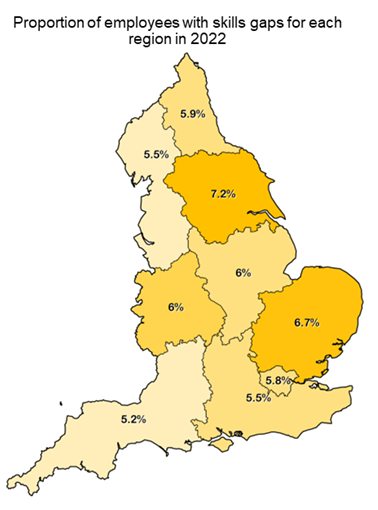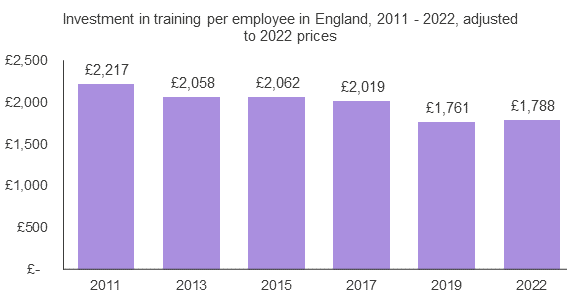Employer survey paints familiar picture…
Last week, the government published the 2022 national employer skills survey – a survey of over 70,000 employers examining the skills challenges they face. It reveals that we continue to face substantial skills issues which are holding back productivity, growth, and social mobility.
Skills shortage vacancies are at their highest level since survey began…
In 2022, businesses struggled to fill over one-third of all vacancies due to skills shortages, i.e. a lack of skills, qualifications, or experience amongst applicants.
The chart below shows the percentage of all vacancies reported by employers as skills shortage vacancies in England between 2011 and 2022 – showing a steady increase from 15% in 2011, to 23% in 2015, and then 36% in 2022.
Over the same period, the total number of skills shortage vacancies reported by employers in England increased from 77,000 in 2011, to 180,000 in 2015 and 460,000 in 2022.
The survey also highlights material differences between regions. The map below shows the proportion of vacancies reported as skills shortage vacancies by region in 2022. It shows that the North West (42%) and the East of England (41%) are the most acutely affected by skills shortages, with over 40% of all vacancies being skills shortage vacancies in these regions. Perhaps surprisingly, London has the lowest proportion (32%).
Skills gaps in the workforce also hit new heights in 2022…
The survey also shows an increase in skills gaps in the workforce – i.e. where an employee that is in post is judged by their employer to lack full proficiency.
The chart below shows the proportion of all employees in England who their employers reported as having skills gaps between 2011 and 2022 – showing a rise in skills gaps from 4.3% in 2017 to 5.9% in 2022, i.e. the highest level of skills gaps recorded.
The map below shows the proportion of employees reported as having skills gaps by region in 2022. It paints a slightly different picture to that shown by skills shortages. The North West (5.5%) fairs better than much of the country, while Yorkshire and the Humber (7.2%) and the East of England (6.7%) have the largest skills gaps in their workforce.
Employers’ investment in training is falling over time…
Employers are investing almost 20% less in training per employee than they were in 2011. The chart below shows employers’ spend on training per employee from 2011-2022 in England, adjusted for inflation. It shows that spend per employee has reduced from over £2,200 per employee in 2011 to under £1,800 in 2022.
Over the same period, the proportion of employers providing training for their employees has decreased from 66% in 2017 to 60% in 2022. Smaller employers tend to invest more in their employees - employers with less than 50 employees spent £2,420 on training per employee in 2022 compared with £1,520 for those with 50 employees or more.
The construction sector is worst hit by skills shortages, while skills gaps hit the hospitality sector hardest…
Different sectors face different skills challenges. The chart below shows the percentage of all vacancies which were skills shortage vacancies by sector in England in 2022. It shows that the construction sector is the most constrained by skills shortages, with employers struggling to fill over half of all vacancies due to skills shortages. Information and communications (43%), health and social work (42%), and manufacturing (42%) all had skills shortages accounting for over 40% of vacancies.
Looking at skills gaps, the story changes somewhat. The chart below shows the percentage of employees reported as having skills gaps by sector in England in 2022.
It shows that hotels and restaurants (8.8%) have the largest issues with skills gaps, while manufacturing (7.9%), financial services (7.7%) and business services (7.1%) all have a skills gap density above 7%.
So what?
TLDR, the report paints a familiar, depressing, picture.
Skills are crucial: to business productivity, performance, and growth; to enterprise and innovation; to sustainability and the pursuit of net zero; and, for individuals, to earnings growth and social mobility. If we fail to invest in training and skills, we undermine those endeavours.
Now more than ever, we cannot afford to clip the nation’s wings through a failure to invest in skills. Productivity has flatlined since the financial crisis – growing by c0.5% per year between 2008 and 2020. Growth is anaemic; the UK narrowly avoided a technical recession last year. Earnings growth is stagnant; indeed real wages have fallen in the past two years.
Government and the business community each need to do more. Government needs to provide a sound, stable and adequately funded skills system; nobody could sensibly claim that successive Governments have done that over the last 16 years.
And businesses need to stop complaining about the apprenticeship levy and start investing in the skills that power their profitability…!







